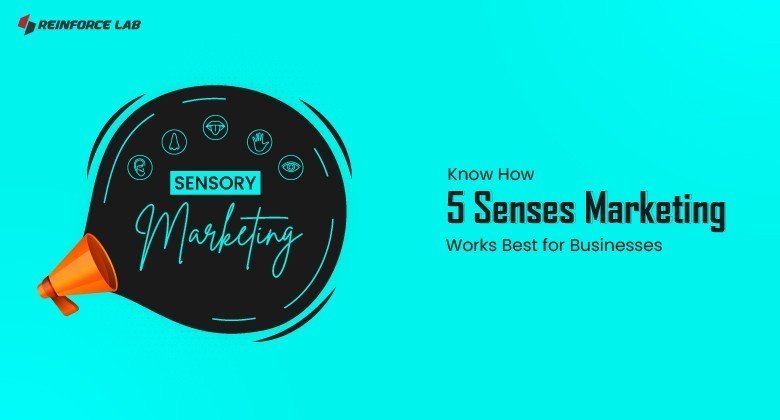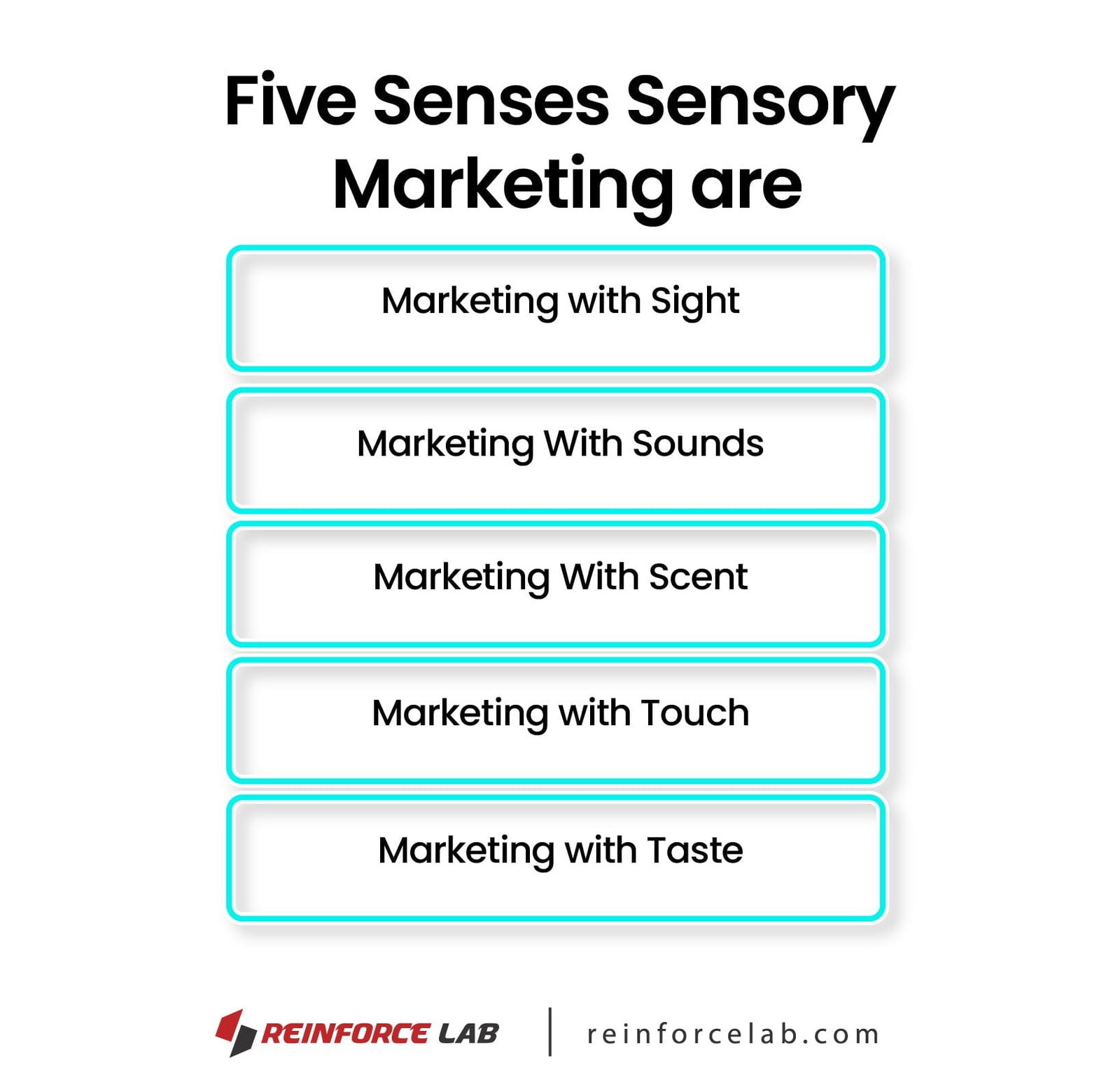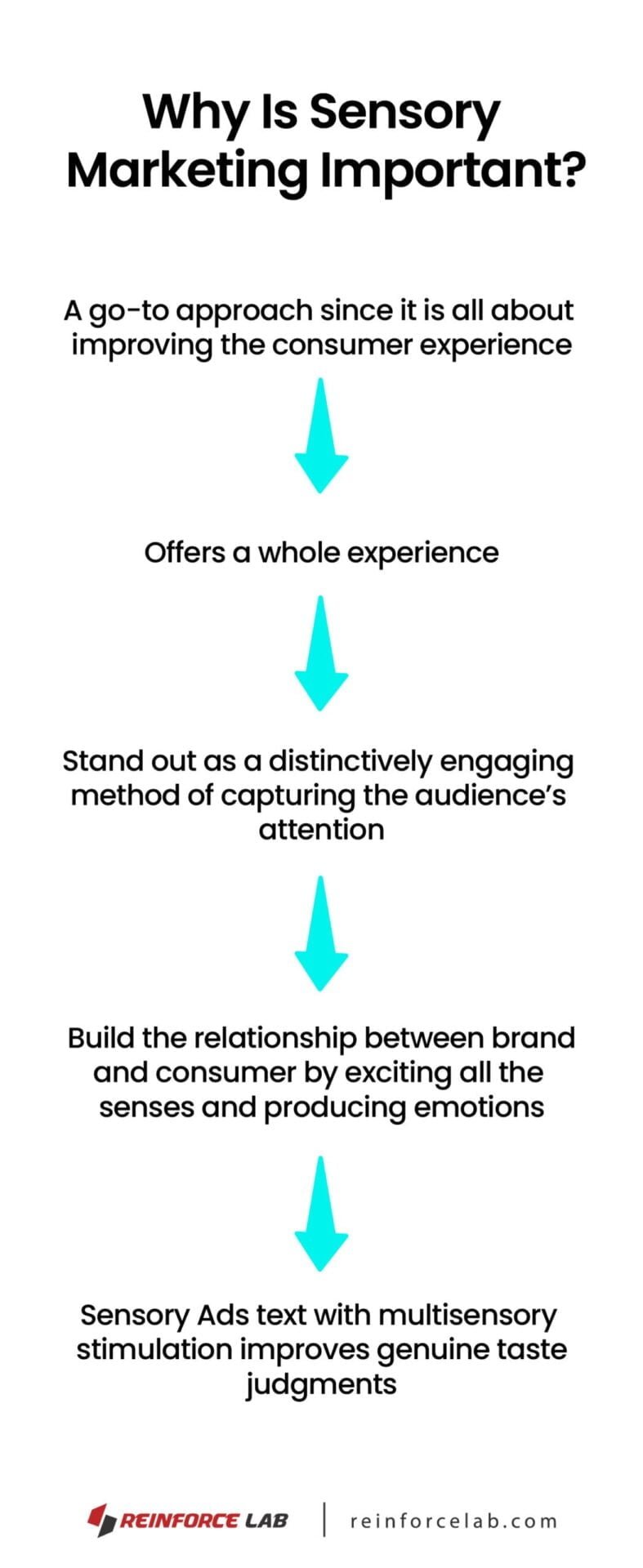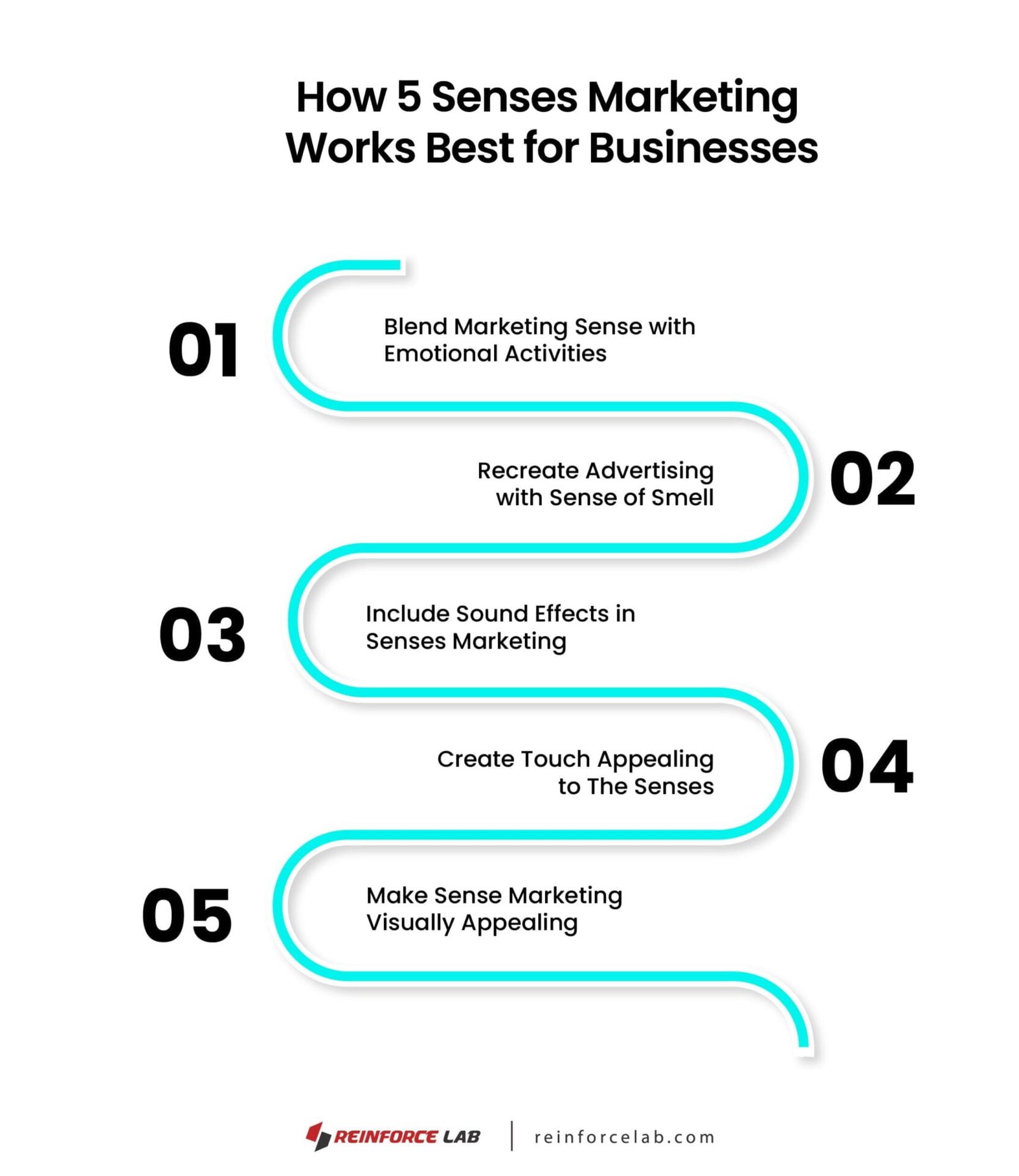Sensory Marketing: Know How 5 Senses Marketing Works Best for Businesses11 min read

Sensory marketing or sensory appeal is one of the effective methods of advertising where the 5 senses marketing approach is applied mainly.
Sensory market research seeks to understand consumers’ views of a product and their whole experience.
According to Science of Sensory Marketing, a certain sensory appeal can alter how a person views an object or activity when connected with that sensory experience.
So, a sensory marketing strategy can be one of the best choices.
As marketing is increasing, trying marketing that plays with people’s senses can help you keep ahead for sure.
I know this sensory appeal sounds quite unorthodox, but trust me, things will be much easier once you understand its algorithm.
For your business at the same time, for your potential customers for sure!
As a marketer, you should apply various marketing techniques to see which is suitable for your business, right?
Here you will get another sensational marketing technique; you can say, called sensory branding or marketing.
So let’s get started then!
Table of Contents
- What Is Sensory Marketing?
- Five Senses Sensory Marketing are –
- Why Is Sensory Marketing Important?
- Brands that Employ Sensory Marketing Examples
- Sensory Marketing –
- Know-How 5 Senses Marketing Works Best for Businesses
- 1. Blend Marketing Sense with Emotional Activities
- 2. Recreate Advertising with a Sense of Smell
- 3. Include Sound Effects in Senses Marketing
- 4. Create Touch Appealing To The Senses
- 5. Make Sense Marketing Visually Appealing
- Wrapping Up – Sensory Marketing
- Know-How 5 Senses Marketing Works Best for Businesses
What Is Sensory Marketing?
Most individuals may be unfamiliar with this notion and wonder, “What is sensory marketing?”
Although there are several methods for sense marketing definition, the sensory marketing concept remains consistent.
Simply said, marketing with sense is the implementation of a marketing plan with emotional connections that appeal to customers.
Sense marketing’s definition appeals to the five senses of the audience: sight, sound, touch, taste, and smell.
The marketing tool of sensory marketing entails a variety of ways to reach your customers’ senses.
And they are influencing their behavior depending on how your brand and tactics make them feel aside from traditional marketing.
Using media senses in advertising and marketing campaigns may significantly impact your audience for your product or service.
Also, their choice to purchase your goods is how sensorial emotional appeal works.
Like sense marketing definition, now see something directly connected with this sensorial emotional appeal!
Five Senses Sensory Marketing are –
Marketers use marketing with senses to catch their target audiences more perfectly.
Obviously, marketing with sense helps a lot in retargeting your potential consumers as its effects are intense emotional connections.
Five senses of sensory marketing that marketing use as a marketing tool in its best ways are –
1. Sensory Marketing with Sight
Here marketers attract consumers with unique or brand-related –
- Colors
- Images
- Text
- Graphics
- Video
- Light
In this way, they properly use the sense marketing definition.
2. Sensory Marketing With Sounds
Using this type of sense can attract consumers most and marketers use –
- Voice Overs
- Sound Effects
- Thematic Music
To let consumers know about a specific brand so that they can remember faster after hearing that tune or music anywhere anytime.
3. Sensory Marketing With Scent
Smelling works best in case of memorizing anything and brands use this option much fruitfully with –
- Environmental Scents
- Fragrances
- Food Scents
The more unique smell the more brand awareness you can get and this is how marketing with scent works.
4. Sensory Marketing with Touch
Touching sense can be remembered years after years so marketers never fail to use this sensory marketing tactic.
Marketing with touch does not mean you will have to allow your products for touching randomly, instead, it works with –
- Comfort
- Collateral
- Hands-On Tests
So people can simply judge w2hat they are offering in person and trust me this system, works best!
5. Sensory Marketing with Taste
People’s sense of taste with taste buds is the best thing that you can use for your promotions.
And how do marketers usually do that?
See the ways –
- Samples
- New Flavors
This way people can get the varieties in their product selection which helps them to see what they should choose.

Why Is Sensory Marketing Important?
There are thousands of reasons available for your business to define it as a sensory marketing brand.
But for that, you must apply a suitable sensory branding strategy; otherwise, it will not work.
Here are 5 reasons why sensory testing is essential!
01. Sensory marketing is a go-to approach since it is all about improving the consumer experience
This sort of marketing mainly plays with the senses of the audience.
So this marketing approach includes things that can give comfort to audiences.
As a result, consumers absorb more of this type of marketing method.
Ultimately businesses with sensory marketing can improve the consumer experience.
02. Mainly, the sensory appeal offers a whole experience
Sensory marketing brands take the advantage of people’s 5 senses.
So ultimately they can easily win people’s hearts if the approach can be applied perfectly at the same time uniquely.
Offering marketing methods including satisfying customers’ 5 senses can work better than any other technique.
That is why it is one of the biggest important issues to go for this theory as it gives the whole experience to any consumer.
03. It can stand out as a distinctively engaging method of capturing the audience’s attention
While blending marketing sense with people’s emotions can easily catch people’s attention.
If you know the proper strategy and how things work in this marketing method then things will be easier enough.
Trust me marketing brands of sensory appliances use this method in order to get much engagement and they became succeeded.
So if you can get proper ideas on how sensory marketing works nothing can stop your business!
04. Build the relationship between brand and consumer by exciting all the senses and producing emotions
Customers want to interact with businesses that do good or make them feel good and also sense of taste good.
And you can simply make them feel something by using sensory marketing.
Customers who are emotionally committed to a brand are less likely to switch to a competitor brand.
You’ve gained their trust and will be rewarded with higher client retention.
05. Sensory Ads text with multisensory stimulation improves genuine taste judgments
Consumers’ senses are aroused when they can eat, smell, or listen to your sensory appeal;
Following sense marketing definition, the brain combines information from these many sensory inputs guarantees.
That the tasting experience with a sense of taste is always multimodal.
As a result, consumers can readily sense how your offerings are as marketing experts.
And they will remain loyal to your business regardless of what happens.

Brands that Employ Sensory Marketing Examples
Companies that use sensory marketing in their branding strategies never fail to tempt their target audiences, which is a thousand times true.
Let’s learn about some examples used by marketing experts that will surely realize how effective sensory marketing is!
So starting with –
Apple
Customers may interact with the company through very immersive in-store experiences.
The stores, which are decked in Apple’s distinctive white, are a visual feast,
All of their retail stores or shops are crammed with products you can touch, play with, and experience.
Apple stores are an essential aspect of Apple’s sensory marketing approach.
As well as a sense of marketing definition to expose people to the lifestyle Apple gadgets promote.
MASTERCARD
Mastercard is leveraging sensory appeal to establish a new identity for credit card users — the “sonic identity,” to be precise.
When a customer completes a transaction, they hear the sonic sound.
The sound is intended to represent the meeting of the red and yellow circles in Mastercard’s logo.
That noise creates a sense of security and consistency – because of the familiar sound, customers know their transactions were successful.
Customers can nevertheless get a fictitious visual experience.
Marriott Hotels
Marriott Hotels employed a virtual reality headset to transport its guests to holiday places where Marriott has a presence.
By allowing them to see famous spots as well as experience odors and noises connected with the area.
VR and AR bring a visual layer to marketing, which is critical for companies but much more appeal to customers.
It takes a visual or text ad and enhances it in such a manner that it becomes more interactive and tailored for customers or clients.
Using an AR app can assist clients in deciding whether they want to visit this place in person and use Marriott as a service provider.
So you easily guess how this aside from traditional marketing this sort of marketing works for businesses to grow flawlessly, right?
I know you can!
Now let’s see how going into a sensory experience can help in
Sensory Marketing –
Know-How 5 Senses Marketing Works Best for Businesses
1. Blend Marketing Sense with Emotional Activities
Emotions are more important in marketing now than ever before.
If you want your clients to believe in your brand, you must first create an emotional appeal to them.
Airbnb, for example, does this brilliantly with its “Belong Anywhere” marketing.
Consider this: the deeper you can connect emotionally with your readers, the they will likely remember your brand.
This, in turn, will allow you to appeal to their other media senses as well.
2. Recreate Advertising with a Sense of Smell
In South Korea, Dunkin’ Donuts employed sensory marketing by releasing a coffee fragrance into the air while playing their business jingle.
Even if this sounds a little far-fetched for your company, there are still techniques to appeal to your clients’ sense of scent.
Placement of scented advertisements in major publications and the use of a signature fragrance in your businesses are two clever possibilities.
Smell is a strong sense, and studies have shown that pleasant fragrances may boost mood by 40%.
Find a way to include smell in your brand to stick with the sense marketing definition.
However, when employing scent in your advertising, be sure that the aroma is not overpowering.
While fragrance has the ability to evoke happy memories, it also has the ability to repel your audience.
I approached this feeling with caution and purpose.
3. Include Sound Effects in Senses Marketing
In advertising, sound may take numerous forms.
It may be the State Farm jingle “Like a nice neighbor…” or a catchphrase you can’t get out of your brain.
Today, sensory advertising necessitates that all firms and retail stores use sound in their branding initiatives.
If something appears tough, know there is always a way to do it.
Consider the lingerie behemoth Victoria’s Secret,
which plays classical music in its stores to make clients feel as though they are part of an exclusive shopping experience.
According to a 2018 survey by Mood Media, 75 percent of customers will stay in a business if they love the music.
4. Create Touch Appealing To The Senses
Touch is a powerful sensation that most companies can quickly capitalize on.
There is almost always a method for your brand to benefit from texture.
This may be choosing substantial, high-quality card paper for your postal adverts.
Or going above and above to ensure your items feel lovely in the customer’s hand.
Whatever method you use, make sure that you are not neglecting this critical sensory opportunity in your marketing.
5. Make Sense Marketing Visually Appealing
Of course, sight is one of the most potent senses in the world of advertising.
Fortunately, it’s also one of the most superficial marketing senses to master.
To emphasize the importance of sight, ensure that your company’s website is visually appealing to clients,
or employ an expert to create your social media or advertising visuals.
Color is an essential component of sight, and companies such as Coca-Cola and Virgin Airlines have used color to build brand awareness for their goods.
The logos of these companies are instantly recognizable all across the world.
If you don’t already have a color scheme for your company, now is a great time to create one.
Hire a professional web design company if you don’t feel comfortable doing it on your own.
Since color says so much about your brand, this is one marketing step that’s well worth investing in.

Wrapping Up – Sensory Marketing
Know-How 5 Senses Marketing Works Best for Businesses
Now you can imagine how sensory appeal or 5 senses marketing is, right?
Hopefully, it is a yes.
With these basic ideas and strategies, you can help other folks seeking which approach they can apply to their business.
Even you can inspire your readers to continue returning to your website and obtain more traffic by applying the perfect sensory appeal indeed.
Remember that business owners’ main marketing tactic is word of mouth.
If you can spread the word and show your authenticity, you can win the market quickly as one of the perfect sensory marketing brands.
And the suitable 5 senses marketing agency can take your business another level up!
Another thing, creativity lies in you.
Create your sensory branding strategies and ensure that they are all ready for mobile optimization.
But perfection comes from professionals, so go for the best always.
Now, I’d like to hear about sensory marketing brands ideas or strategies that you have applied or planning to do?
Can you tell me the ways that you have applied?
Could you share your thoughts with us?
Learn more about our Social Media Marketing Services!
Read more from our blog.
You May Also Like:
- 40 Content Marketing Ideas for Social Media 2025
- 20 Social Media Content Ideas for Photographers 2025
- 18 Content Marketing Ideas for Real Estate 2025
- Church Marketing Strategies: How to Market a Church 2025
- 16 Content Marketing Ideas for Small Business 2025
- Content Marketing vs Social Media Marketing: Which One is Best?